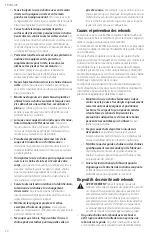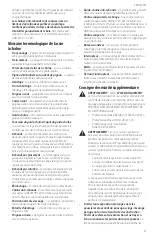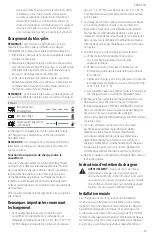
English
12
Fig. K
3
13
Testing the Chain Brake
Test the chain brake before every use to make sure it
operates correctly.
1. Place the tool on a flat, firm surface. Make sure the saw
chain
5
is clear of the ground.
2. Grip the tool firmly with both hands and turn the chain
saw on.
3. Rotate your left hand forward around the front handle
13
so the back of your hand comes in contact with
the chain brake/front hand guard
3
and push it
forward, toward the workpiece. The saw chain should
stop immediately.
nOTE:
If saw does not stop immediately, stop use of tool
and bring it to an authorized service center nearest you.
WARNING: Make sure to set chain brake
before cutting.
ON/OFF Switch (Fig. L)
Always be sure of your footing and grip the chain saw firmly
with both hands with the thumb and fingers encircling
both handles.
To turn the unit on, ensure chain brake is not engaged.
Push the lock off lever
2
and squeeze the On/Off trigger
switch
1
. Once the unit is running, you may release the lock
off lever.
In order to keep the unit running you must continue to
squeeze the trigger. To turn the unit off, release the trigger.
nOTE:
If too much force is applied while making a cut the
saw will turn off. To restart saw, you must release the
On/Off trigger switch
1
before the saw will restart. Begin
your cut again this time with less force. Allow the saw to cut
at its own pace.
WARNING: Never attempt to lock a switch in the
ON position.
Fig. L
1
2
Bubble Level (Fig. A, Q)
WARNING:
Do not operate above shoulder height
Align bubble levels prior to making a cut.
Ideal for horizontal cutting to ensure a straight, flat cut for
fencing, decking or railing posts.
1. Align both bubble levels
7
.
2. Always start a cut with the saw chain running at
full speed.
3. Place the bottom spike
20
of the chain saw behind the
area of the initial cut.
4. Once a cut has begun and a notch is established in the
material, do not change the angle of the cut.
nOTE:
Changing the angle will cause the bar to bend.
Common Cutting Techniques (Fig. A, M–S)
Felling
The process of cutting down a tree. Be sure battery is fully
charged before felling a tree so you can finish on a single
charge. Do not fell trees in high wind conditions.
WARNING:
Felling can result in injury. It should only
be performed by a trained person.
• A retreat path should be planned and cleared as
necessary before cuts are started. The retreat path
should extend back and diagonally to the rear of the
expected line of fall (Figure M).
DIRECTION
OF
FALL
RETREAT
45°
TREE
Fig. M
45°
RETREAT
• Before felling is started, consider the natural lean of
the tree, the location of larger branches and the wind
direction to judge which way the tree will fall. Have
wedges (wood, plastic or aluminum) and a heavy mallet















































